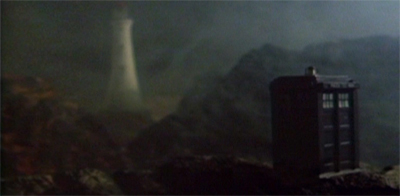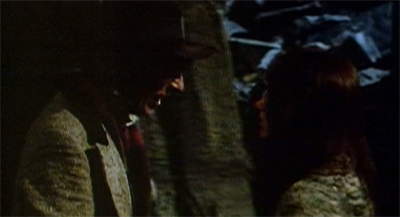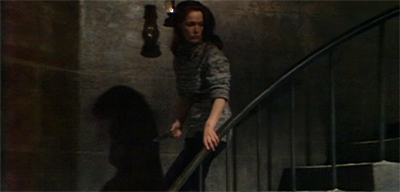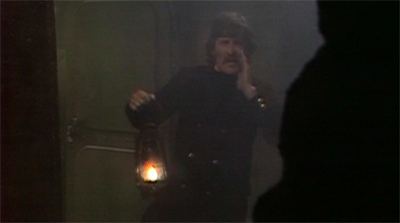To celebrate the fiftieth anniversary of the longest-running science-fiction show in the world, I’ll be taking weekly looks at some of my own personal favourite stories and arcs, from the old and new series, with a view to encapsulating the sublime, the clever and the fiendishly odd of the BBC’s Doctor Who.
Horror of Fang Rock originally aired in 1977.
So you found the trouble then?
Yes, I always find trouble.
– Vince and the Doctor
The show was on something of a hot streak when Horror of Fang Rock aired. While producer Philip Hinchcliffe’s tenure on the show is roundly praised, and is a personal favourite, the standard of the show had been particularly high. The beloved Talons of Weng-Chiang had closed out the previous season, following hot-on-the-heels of the well-regarded Robots of Death – both classic and iconic stories that stand as the very best of Tom Baker’s time in the lead role. Horror of Fang Rockis right on up there, as perhaps one of the best gothic horrors that the series has ever produced.
Reportedly, the season opener was written in a tremendous hurry by Terrence Dicks when his earlier script became unworkable – apparently his script involved vampires, and the production team didn’t want to step on the toes of a major BBC adaptation of Dracula planned for that year. Perhaps because of the hurry with which it was written, Dicks manages to incorporate all the hallmarks of the Doctor Who of this era. However, the writer also manages to find a way to exemplify them. Horror at Fang Rock doesn’t just encapsulate the show at this point in time, it represents the very best of it.
The story is remarkably straightforward. The Doctor and his companion land at the site of a mysterious incident without meaning to, and get caught up in a series of strange and macabre goings-on while they struggle to keep the locals alive in the face of an other-worldly threat. It’s pretty much one of the standard story templates for the show, and one that is still used to this day. However, it’s the execution that makes Horror of Fang Rock distinct from all the similar stories in the show’s fifty-year history.
Director Paddy Russell was a veteran of the show at this stage, having worked with both William Hartnell and Jon Pertwee. She’s also the director responsible for the well-received Pyramids of Mars, another fine example of the show’s gothic tendencies. The action confined to a small light house on a craggy little island, Russell manages to keep the tension boiling over for all four episodes, a remarkable accomplishment. Dick does a great job in making the supporting cast seem like more than just a bunch of randomers with very little time left on their biological clocks. It also helps that Tom Baker was at the top of his game around this point in the show’s history.
And, really, while Baker isn’t my personal favourite Doctor, there’s no denying his tremendous screen presence. He always looks like he’s having a good time. Dicks writes some wonderful dialogue, but it’s Baker who makes it sing. “Gentlemen,” he declares, “I’ve got news for you. This lighthouse is under attack and by morning we may all be dead! Anyone interested?” His version of the character “speaks with an amazing air of authority.” Lord Palmerdale asks, “Are you in charge here?” Baker looks up with that fiendish grin he has and replies, “No, but I’m full of ideas.”I honestly don’t think any other actor in the role until Tennant could make so much of so little, and the serial stands as one of countless testaments to Baker’s skill.
However, it also has a whole lot more going for it. Everybody undoubtedly has their favourite companion – and Baker probably had the most interesting and diverse companions of any Doctor. While most people will remember Elisabeth Sladen as Sarah Jane, I think it’s easy to underestimate just how brilliant – and how fresh – a companion Leela was. A primitive savage from another world, Leela fulfilled the companion’s job of allowing the Doctor to spout exposition, but she’s also a radical departure from most of the other female characters to travel with the Doctor, in that she’s quite able to take care of herself. While her distinctive brown loincloth isn’t going to convince many feminists, the character was a lot stronger than others, and – despite coming from a less sophisticated society – was less dependent on the Doctor. It makes me feel all the worse that the new series has confined itself to modern-era Britons to keep the lead company.
Indeed, Dicks’ script seems to feel the need to outsource the traditional “screaming and fainting woman” to a member of the guest cast, while Leela skulks around in the fog with a sharp knife, hunting the creature that’s supposed to be hunting them. It was a huge step forward in how the show portrayed the supporting cast, and one that continued with the equally independent Ramona (I & II), but unfortunately regressed shortly afterwards. Baker might not have wanted to share the screen (and was reportedly quite difficult for Jameson to work with), but I think that Leela added quite a bit to the show. I don’t think she’s the most iconic or the “definitive”companion, but she worked really well and the story plays to her strengths.
All of this, however, would be nothing without Dicks’ rather wonderful script. The serial has all the trappings of a great gothic horror. There’s the remote setting and barren wasteland, made all the more eerie by a sudden fog and a sharp drop in temperature. There’s the local mythology about “the Beast of Fang Rock” – “superstitious nonsense” – which appears to be acting itself out. There’s a prophecy of horrors to come, as foreseen by Adelaide’s “astrologer” (a spiritual descendent of Leela’s “shaman”). There are signs of violence in nature, with dead fish floating in rock pools, and an eerie green glow.
Hell, there’s even the suggestion of the dead walking the Earth, with a wise old light house hand claiming that “a man who died like that will never rest easy.” All of these factors are explained by a crashed alien ship and a shape-changing extraterrestrial monster, but the story does very well to treat them as elements of a gothic ghost story. That’s undoubtedly how the mysterious deaths will be recorded in folklore anyway, isn’t it? I know the show was made on a shoestring, even back then, but stories set in the past always looked considerably better than stories set in the future, if only because of the BBC’s skill for period drama – and this looks like a classic gothic horror, perfectly.
Dicks actually captures the spirit of those types of stories relatively handily. It feels like a classic little horror novella, right down to the guests trapped in the light house. There are the superstitious staff working the light house, and members of high society in the middle of very shady goings on. Indeed, I love the way that Dicks suggests that the greed of those wealthy individuals – which led to the death of the sailor on their yacht – has drawn this fate on them like some form of laser-guided karma. Notions of “guilt” and “sin” help the story feel just a little bit more like a classical folk tale, where the wicked and greedy face some otherworld punishment for their misdeeds. One gets the sense that this would have been a fascinating little tale if the Doctor and Leela hadn’t shown up, and that’s why it works so well. There’s a sense that – had the TARDIS never been drawn off course – this moment in history might have been captured as the return of “the Beast of Fang Rock.” Well, it would also have served as the beach head of an alien invasion of the planet as well.
Even the dialogue between the Doctor and the invading Rutan is sparkled with a sort of wit and energy. I think that’s what made the series so much fun – the fact that it was wry and self-aware even when going through the classical tropes of science-fiction. very few other series would take time out from a gothic horror to crack jokes about the Rutans’ “strategic withdrawal” in a large-scale intergalactic conflict. It’s just one of the countless little touches that help set the show apart.
Horror of Fang Rock isn’t a bold or revolutionary episode, but it does succeed at doing what it set out to do with remarkable skill. It perfectly captures the turn-of-the-century feeling that a story like this needs, while being brilliantly efficient and superbly effective. It’s the Doctor Who storytelling engine working at its very best.
Filed under: Television | Tagged: art, bbc, British humour, Doctor (Doctor Who), doctor who, DoctorWho, fiction, Horror of Fang Rock, Jon Pertwee, Online Writing, Paddy Russell, Philip Hinchcliffe, Pyramids of Mars, science fiction, The Horror of Fang Rock, Tom Baker, William Hartnell |


























Leave a comment